עם רכיבי OHS קל יותר להטמיע FHIR. אפשר להשתמש בהם בנפרד או לשלב אותם כדי ליצור את הבסיס של פלטפורמת בריאות דיגיטלית מקצה לקצה.
אפליקציות ל-Android מבוססות FHIR
באמצעות Android FHIR SDK, המפתחים יכולים ליצור במהירות אפליקציות מקוריות ל-Android. ה-SDK הוא מערך מודולרי של ספריות שמיועדות לספק גמישות למגוון תרחישים שונים לדוגמה. למשל:
- הספרייה לתיעוד נתונים מובְנים באפליקציה קיימת, כדי להפעיל איסוף נתונים דרך FHIR,
- את FHIR Engine Library כדי לבנות פתרונות אופליין ראשונים ב-FHIR,
- את היכולות המתקדמות של הספרייה של תהליכי העבודה כדי לאפשר תמיכה בקבלת החלטות קליניות על סמך CQL מתוכן ההנחיות החכמות של ארגון הבריאות העולמי.
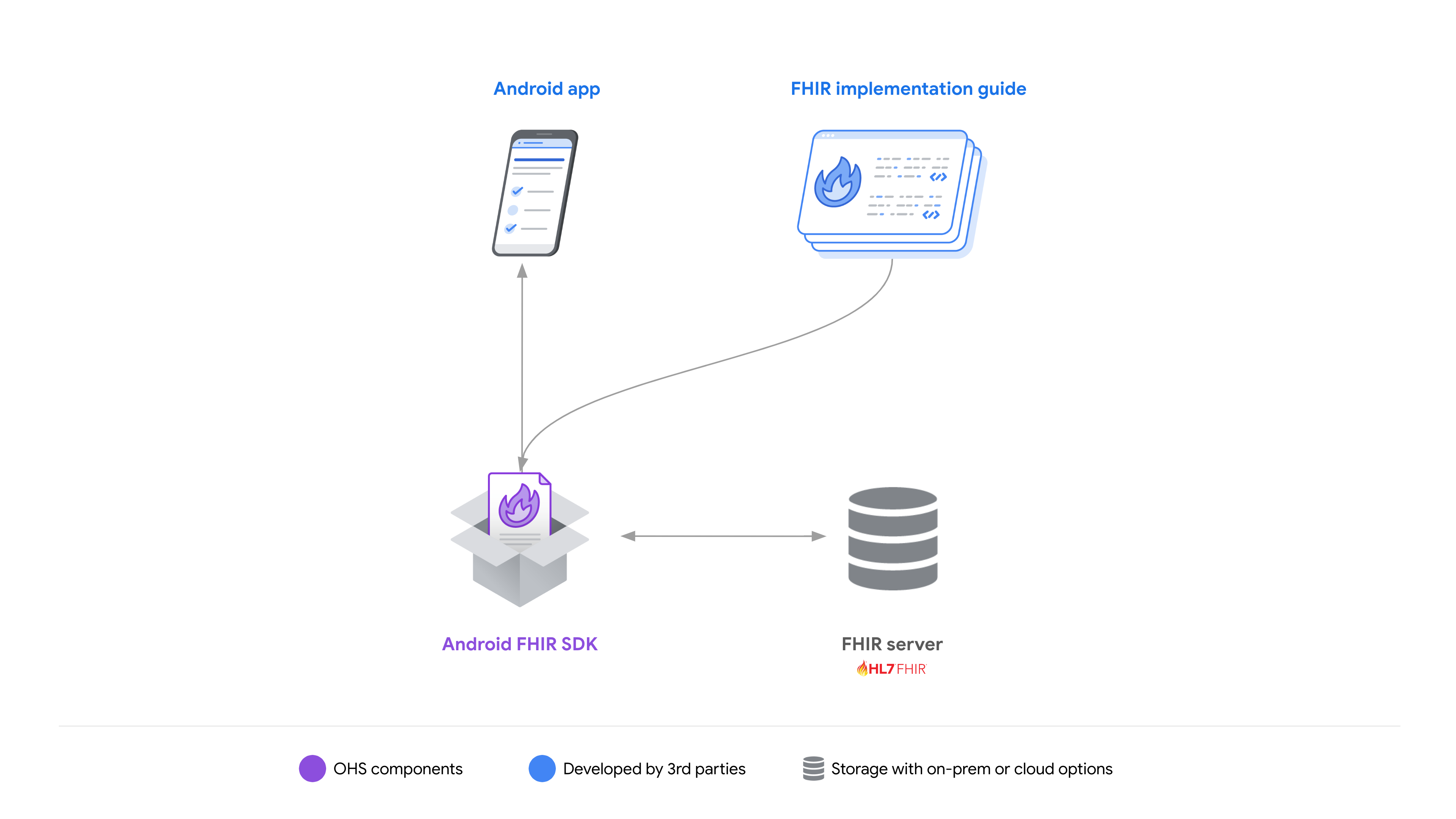
מקורות מידע:
- כדי להתחיל במהירות, השתמשו ב-SDC Codelab.
- כאן מוסבר איך מפתחים יוצרים פתרונות לנייד באמצעות OHS.
שיפור הפרטיות, מינוף של SMART-on-FHIR
FHIR Info Gateway הוא שרת proxy הפוך עצמאי, שאפשר לפרוס מול כל אפליקציה כדי לשפר את הפרטיות ולהקל על ההטמעה של כללי המדיניות הארגונית של בקרת הגישה. כשמשתמשים בשילוב עם אפליקציה שמופעלת באמצעות FHIR SDK של Android, Info Gateway יכול גם לשפר את פעולות הסנכרון. לדוגמה, כדי להגביל את נתוני המטופלים שזמינים להורדה של נתוני מטופלים מסוימים בזמן עבודה אופליין.
שער המידע תומך בשילוב עם אפליקציות SMART-on-FHIR כשרת Proxy עצמאי.
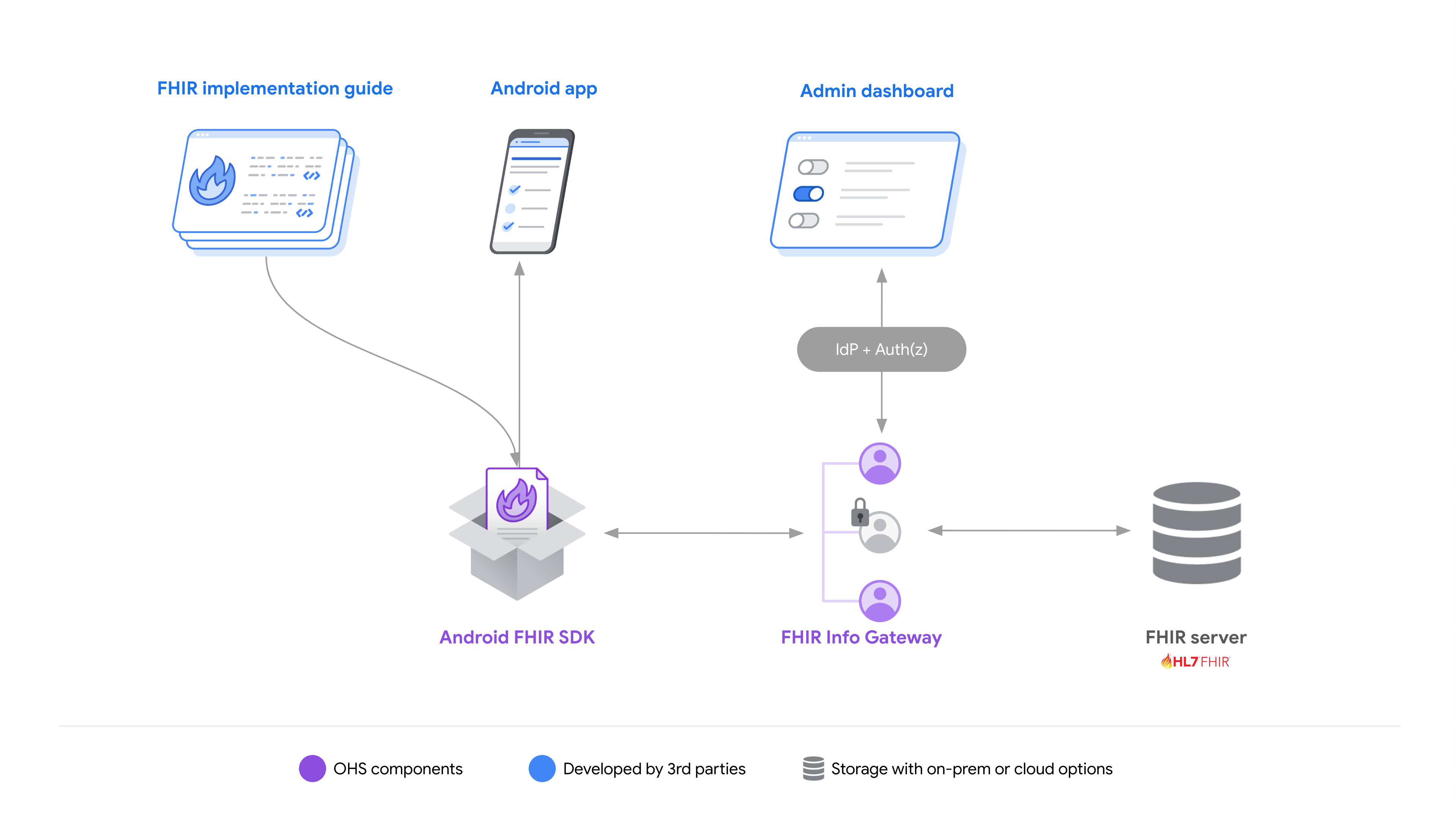
מקורות מידע:
- במאגר הדוגמאות לאפליקציות FHIR אפשר לבדוק איך אפשר להשתמש ב-FHIR Info Gateway עם רכיבי OHS אחרים.
פתרונות של FHIR Analytics
בשל המבנה הכללי של נתוני FHIR, כתיבת שאילתות ליצירת תובנות יכולה להיות מאתגרת. צינורות נתונים של FHIR מפשטים את הבעיה באמצעות צינור עיבוד נתונים שקל לפרוס אותו ולשנות את הגודל שלו לרוחב, שהופך נתוני FHIR לפורמט SQL-on-FHIR, וכך אפשר להריץ שאילתות על נתוני FHIR דרך SQL.
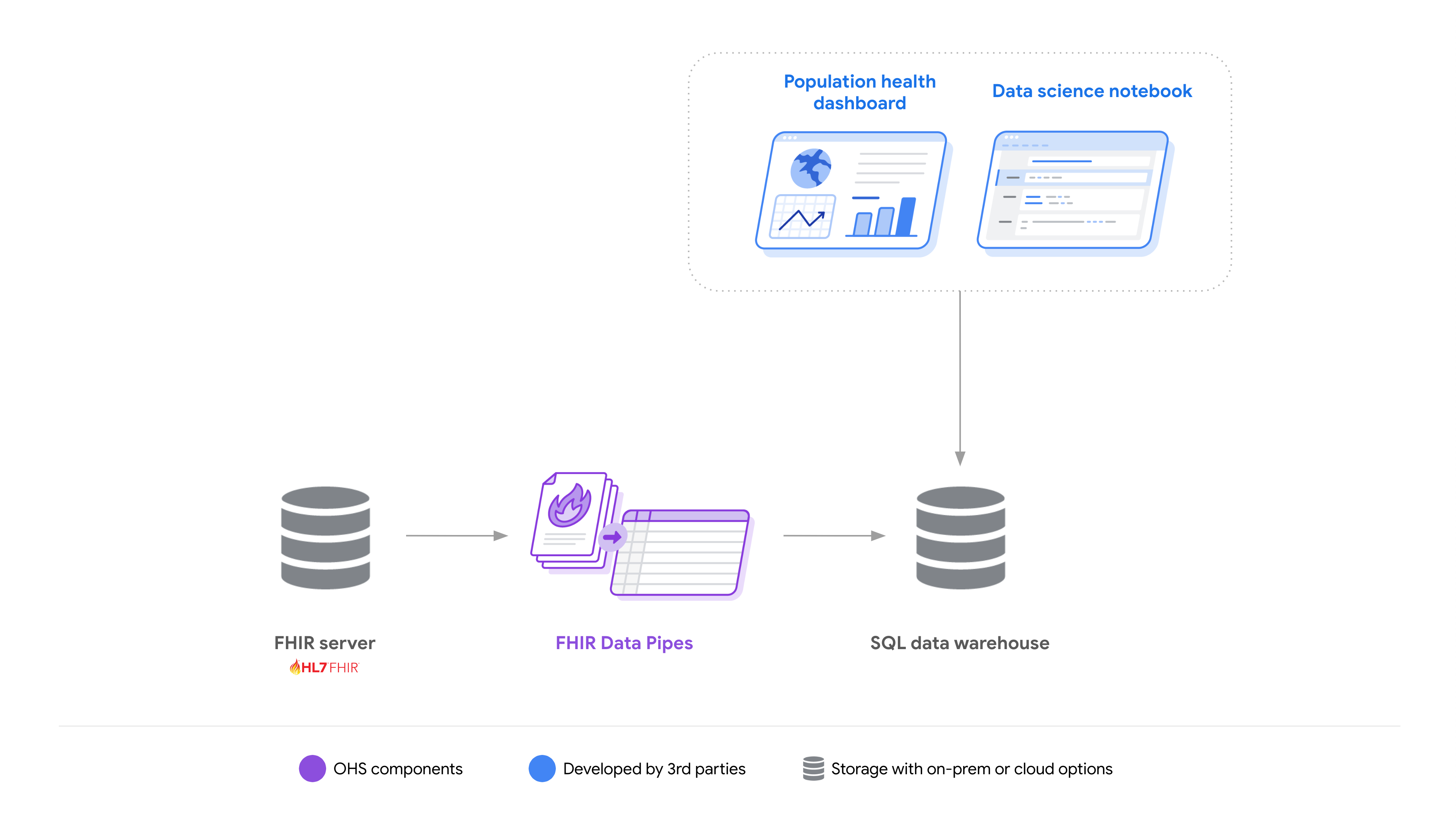
צינורות נתונים של FHIR יכולים לעזור במקרים שבהם FHIR הוא מקור הנתונים לניתוח. בין התרחישים הנפוצים למפתחים:
- כהרחבה לפתרון בריאותי מבוסס-נייד (FHIR) – תוכלו לעיין ביסודות לפתרון כוללני של בריאות בדיגיטל.
- כחלק מפתרון עצמאי לניתוח נתונים שמשתמש ב-FHIR – כאן תוכלו לראות דוגמה לארכיטקטורה היברידית.
מקורות מידע:
- תוכלו להתחיל במהירות בעזרת המדריך לפריסה של מכונה יחידה.
- במאגר לדוגמאות של אפליקציות FHIR מוסבר איך משתמשים בצינורות הנתונים של FHIR עם רכיבי OHS אחרים.
הבסיס לפתרון כוללני של בריאות דיגיטלית
השימוש בכל רכיבי ה-OHS יחד מספק למפתחים בסיס לבניית פלטפורמות ופתרונות שמבוססים על FHIR. בזכות השימוש במספר תכונות מרכזיות, כמו סנכרון ויכולות אופליין, המפתחים יכולים לחסוך זמן רב ולהתמקד בערך המוסף של הפתרונות שלהם.
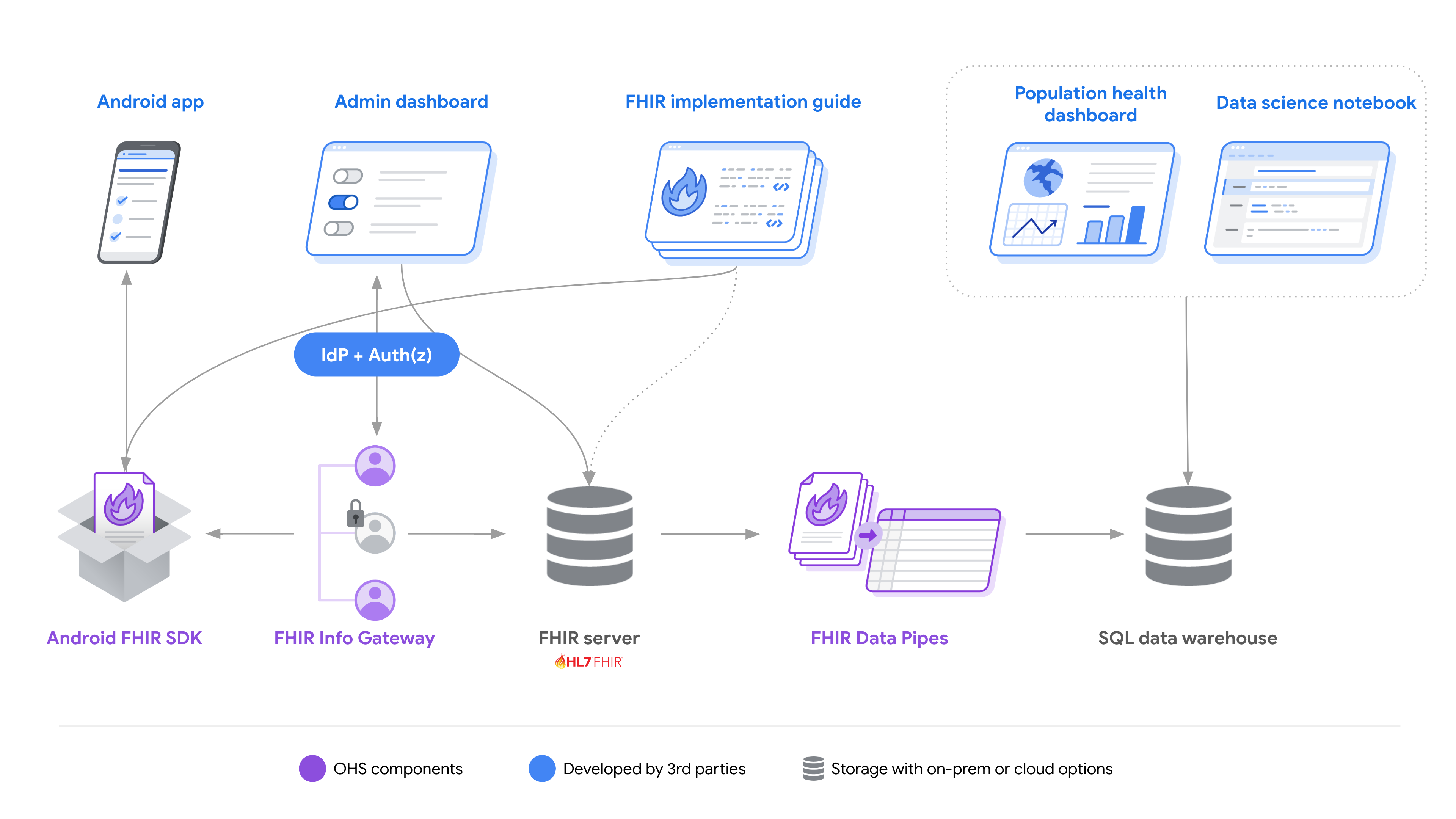
מקורות מידע:
- במאגר הדוגמאות של אפליקציות FHIR אפשר לראות איך אפשר להשתמש בכל הרכיבים יחד.
- כאן מוסבר איך אונה השתמשה ב-OHS כדי לפתח את OpenSRP FHIRCore.
דוגמה לארכיטקטורה היברידית
המודולריות של רכיבי OHS מאפשרת למפתחים לבחור ולבחור את החלקים שיעזרו להם לפתור בעיות ספציפיות בצורה הטובה ביותר.
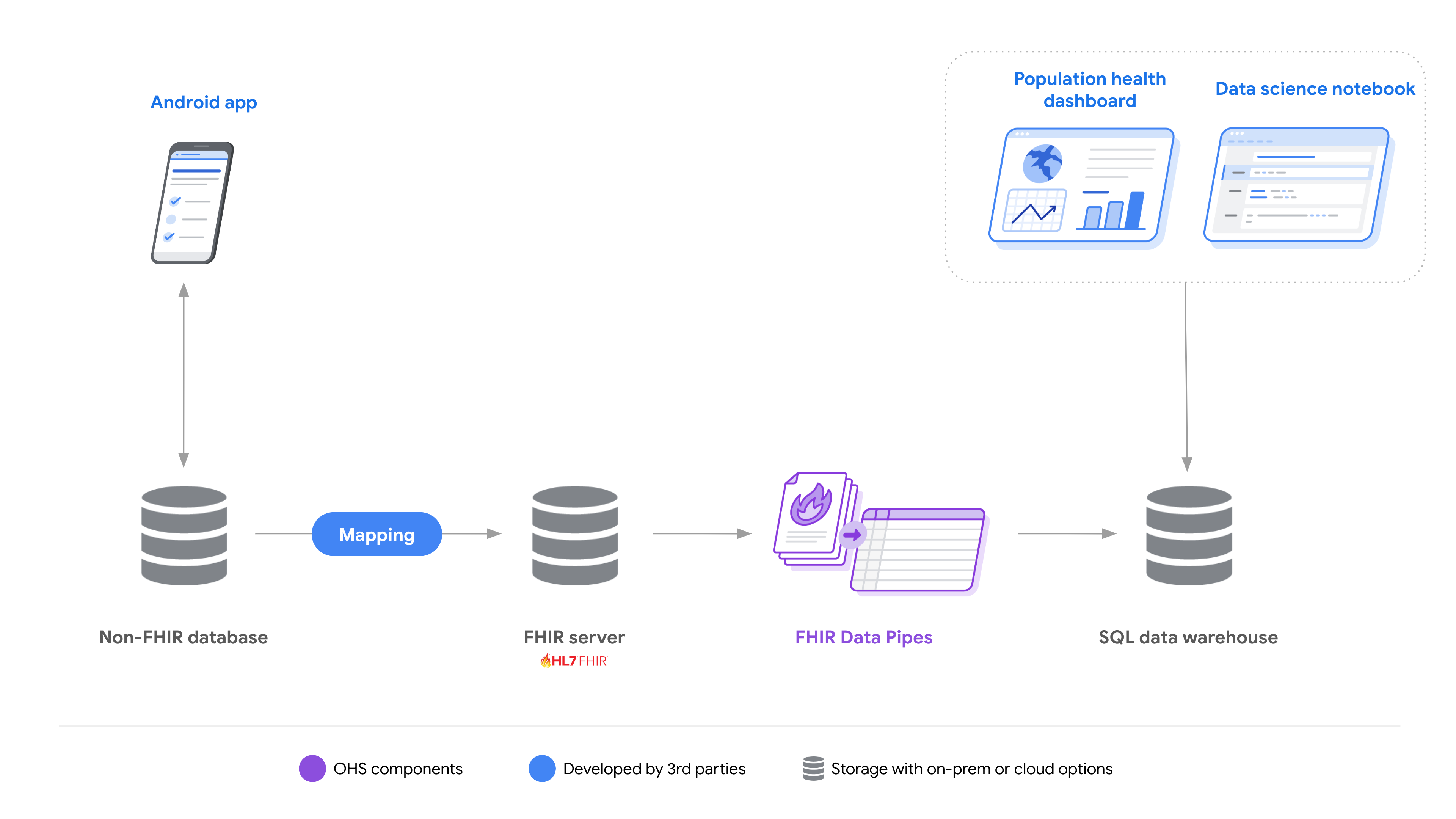
יש הרבה דוגמאות למקרים שבהם כדאי להעביר חלק ממערכת קיימת ל-FHIR, בלי לשנות חלקים אחרים בפתרון. האפשרויות הן:
איסוף נתונים שלא באמצעות FHIR לניתוח שמבוסס על FHIR: בתרחיש הזה, נתונים שנאספים בדרך שאינה FHIR עוברים המרה ל-FHIR כדי לאפשר את השימוש ב-OHS FHIR Data Pipes בגישה משותפת להפקת תובנות מנתוני FHIR. כדי לשנות נתונים, מפתחים יכולים להשתמש בממשקי API קיימים של ספקים, בשירותי צד שלישי קיימים כמו OpenFn שאושרו על ידי Global Goods או להשתמש בפרויקטים רלוונטיים של קוד פתוח.
אפליקציה מקורית של FHIR למערכות שאינן FHIR: בתרחיש הזה, אפליקציה לנייד מקורית של FHIR שנוצרה באמצעות Android FHIR SDK משמשת למתן טיפול אופליין עם נתונים שמסונכרנים לשרת FHIR. מפתחי שרת FHIR יכולים להטמיע שילובים עם מערכות קיימות, מתאמים של צד שלישי או קוד בהתאמה אישית.
מקורות מידע:
- במאגר הדוגמאות של אפליקציות FHIR אפשר לראות איך אפשר להשתמש בכל הרכיבים יחד.

